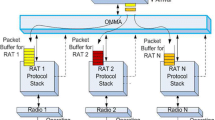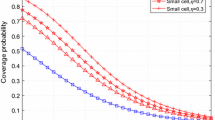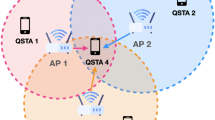Abstract
In this paper we consider the reverse-linkcapacity performance of indoor Slotted-ALOHA protocolsadapted for use with a multibeam smart antenna (SDMA)basestation. When SDMA is used in this application, the basestation attempts to transmit or receivemultiple packets simultaneously using its antenna array.S-ALOHA protocols are well suited for this purpose sincethey permit simultaneous station transmission more readily compared with conventional LANprotocols such as CSMA. It is assumed that the portablestations have omnidirectional antennas and share asingle radio link to the basestation. Versions of the protocols are considered where initial stationaccess occurs in the data slots directly, and when botha single-beam and multibeam reservation channel is usedprior to data slot access. Two slot allocation algorithms are proposed which can be used withthe reservation channel protocols to dynamically assignportable stations to the data channel. It is shown thatsignificant improvements in system capacity are possible when more sophisticated dynamicslot allocation is employed. In the results presented,we optimize the design of each system to maximize thecapacity achieved. The comparisons thus give an indication of the relative trade-offs betweencapacity and complexity possible in such a system. Ofthe cases considered, multibeam operation in bothreservation minislots and data slots can achieve the highest theoretical capacity. However, we findthat when operating under low SNR, and especially forlong packet lengths, only very marginal improvements incapacity are achieved compared with other methods. This is important to note, since operating thesystem with multibeam minislot contention is expected tobe highly complex due to the difficulties of dynamicacquisition. We find that when packet lengths are less than about 2 kbits, there is verylittle capacity advantage in using a single-beamreservation protocol over multibeam slotted ALOHA(S-ALOHA).
Similar content being viewed by others
REFERENCES
N. Abramson, The ALOHA systemÐ another alternative for computer communications. Proceedings, Fall Joint Computer Conference, 1970.
L. G. Roberts, ALOHA packet system with and without slots and capture. Computer Communications Review, April 1975.
J. Ward and R. T. Compton, Jr., High throughput slotted ALOHA packet radio networks with adaptive arrays. IEEE Transactions on Communications, Vol. 41, No. 3, March 1993, pp. 460–470.
C. Sakr and T. D. Todd, Carrier sense protocols for packetswitched smart antenna basestations. International Conference on Network Protocols, October 28-31 1997, pp. 45–52.
R. T. Compton, Jr., Adaptive Antennas, Concepts and Performance, Prentice Hall, 1988.
G. Xu and S. Q. Li, Throughput multiplication of wireless LANs for multimedia services: SDMA protocol design, Proc. GLOBECOM’ 94, August 1994.
F. Shad, T. Todd, V. Kezys, and J. Litva, Indoor SDMA capacity using a smart antenna basestation, Sixth International Conference on Universal Personal Communications, October 1997, pp. 868–872.
R. Sinha, T. Todd, F. Shad, and V. Kezys, Forward link capacity in smart antenna basestations with dynamic slot allocation, Ninth International Symposium on Personal, Indoor, and Mobile Radio Communications, September 1998, pp. 942–946.
J. H. Winters, On the capacity of radio communication systems with diversity in a Rayleigh fading environment, IEEE Journal on Selected Areas in Communications, Vol. SAC-5, No. 5, June 1987, pp. 871–878.
J. Litva and T. K. Y. Lo, Digital Beamforming in Wireless Communications, Artech House, 1996.
S. P. Applebaum, Adaptive arrays, IEEE Transactions on Antennas and Propagation, Vol. AP-24, No. 5, September 1976, pp. 585–598.
D. Bertsekas and R. Gallager, Data Networks, 2nd ed., Prentice Hall, 1992.
D. V. Sarwate and M. B. Pursley, Crosscorrelatio n properties of pseudorandom and related sequences, Proceedings of the IEEE, Vol. 68, No. 5, May 1980, pp. 593–618.
J. H. Winters, Optimal combining in digital mobile radio with cochannel interference. IEEE Journal on Selected Areas in Communications, Vol. SAC-2, No. 4, July 1984, pp. 528–539.
F. Shad, Dynamic Slot Assignment SDMA/TDMA Systems Using a Smart Antenna Basestation, PhD thesis, McMaster University, 1999. Submitted.
R. Sinha, Smart Antennas in Packet Switched Indoor SDMA Networks, Master’ s thesis, McMaster University, September 1997.
H. M. Taylor and S. Karlin, An Introduction to Stochastic Modeling, Academic Press, Toronto, 1984.
Rights and permissions
About this article
Cite this article
Shad, F., Todd, T.D. Indoor Slotted-ALOHA Protocols Using a Smart Antenna Basestation. International Journal of Wireless Information Networks 6, 197–213 (1999). https://doi.org/10.1023/A:1018856005964
Issue Date:
DOI: https://doi.org/10.1023/A:1018856005964




